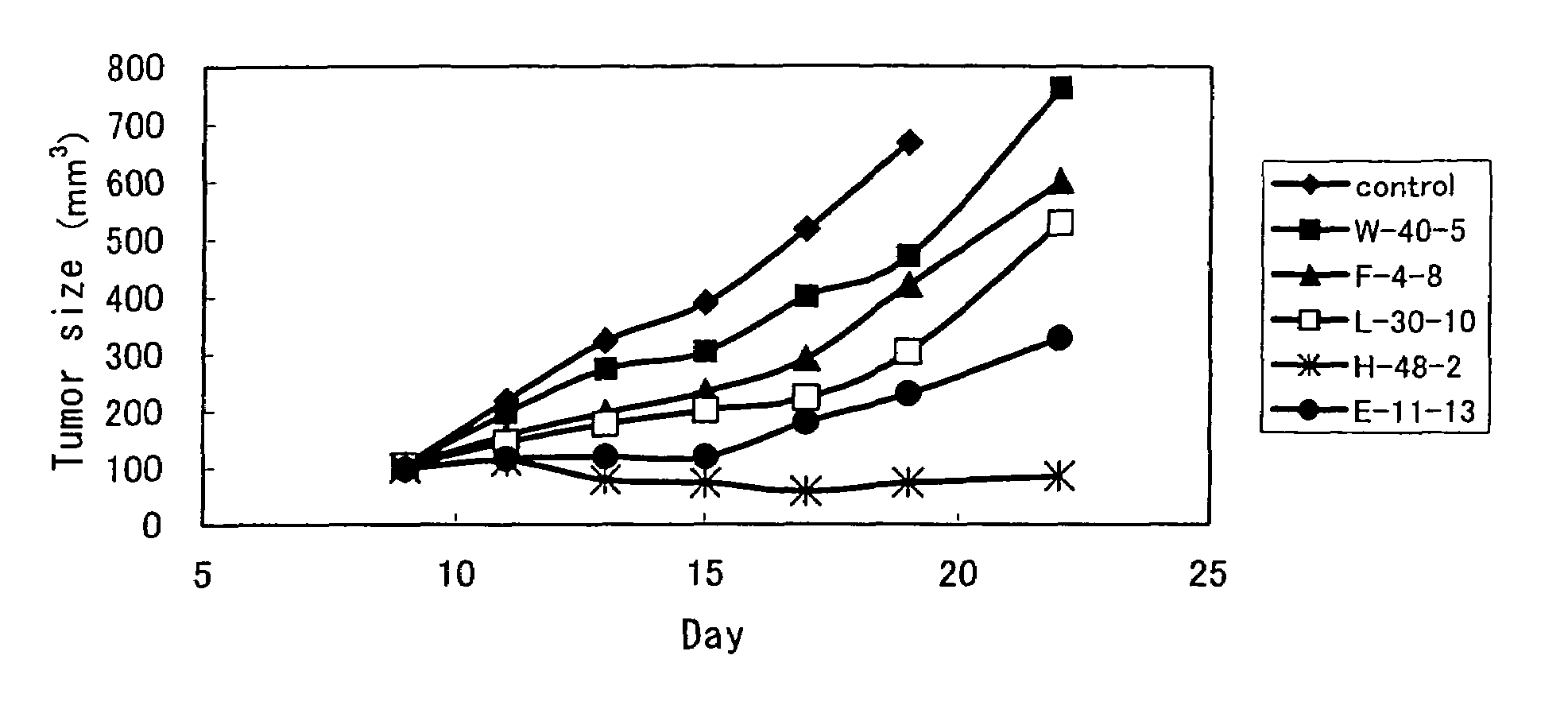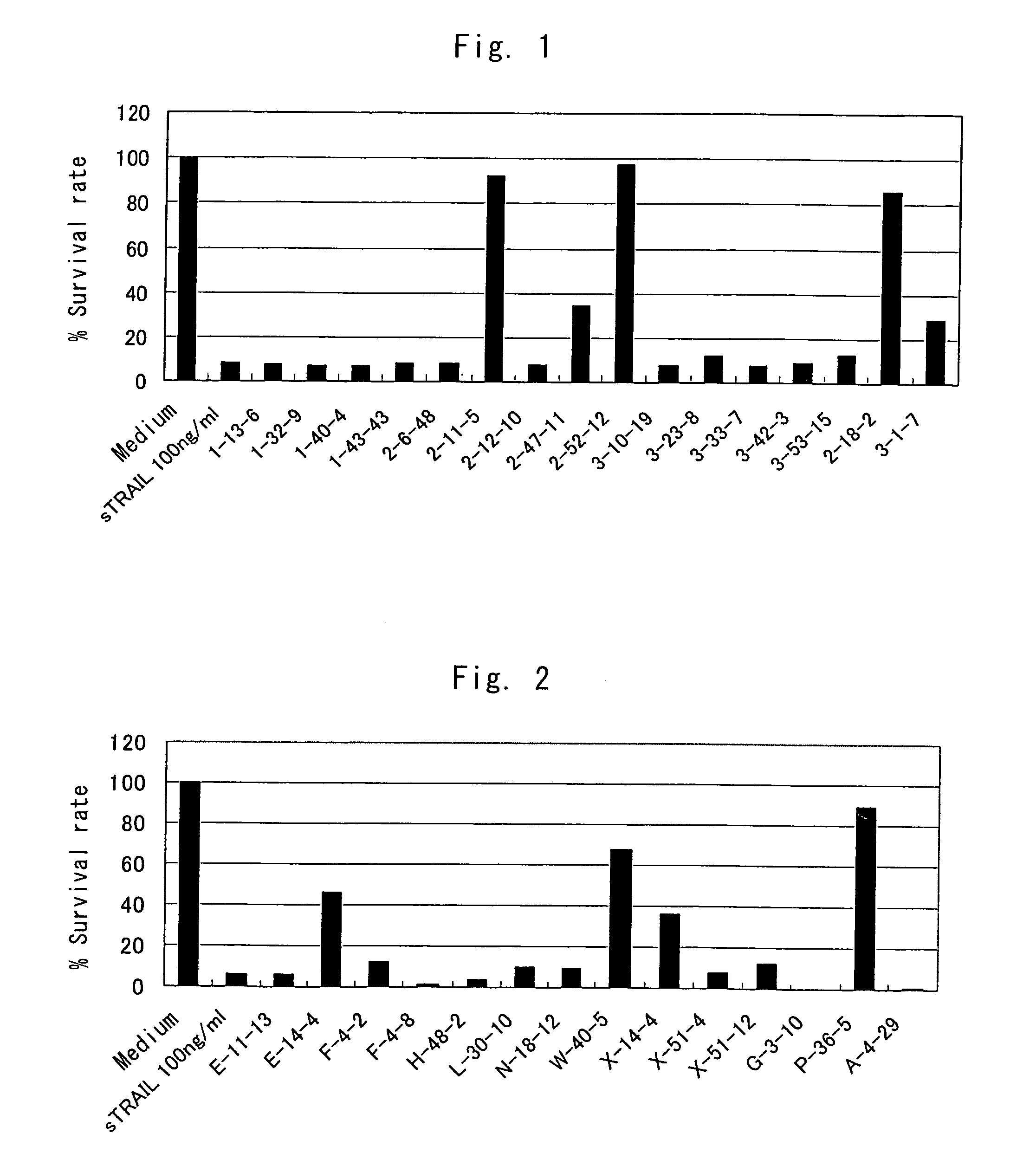Anti-TRAIL-R antibodies
a technology of anti-trail receptor and anti-trail receptor, which is applied in the field of anti-trail receptor (trailr) antibodies, can solve the problems of lupus, herpes virus infection, other problems, and the selectivity has not yet been supported theoretically. it is not known whether or not agonistic antibodies having no toxicity can be obtained
- Summary
- Abstract
- Description
- Claims
- Application Information
AI Technical Summary
Benefits of technology
Problems solved by technology
Method used
Image
Examples
example 1
Preparation of Antigen
[0132]To obtain cells excessively expressing human TRAIL-R1 and TRAIL-R2 on the cell membrane, plasmid vectors for the expression of human TRAIL-R1 and human TRAIL-R2 (which had been prepared by removing the death domain and the amino acids on the C-terminal side from the death domain in the intracellular regions from the full-length amino acids of the human TRAIL-R1 and TRAIL-R2, hereinafter referred to as TRAIL-R1 and TRAIL-R2delta,) were prepared. DNAs encoding TRAIL-R1 and TRAIL-R2delta were prepared by the PCR method.
a) Construction of Full-Length Human TRAIL-R1 and R2 Expression Vectors
[0133]To perform template PCR, plasmid vectors, pcDNA3-TRAIL-R1 and pcDNA3-TRAIL-R2, retaining cDNAs encoding human TRAIL-R1 and R2 were used as templates. pcDNA3-TRAIL-R1 and pcDNA3-TRAIL-R2 were constructed by the following method. The full-length human TRAIL-R1 DNA and TRAIL-R2 DNA were modified by polymerase chain reaction (PCR) to add an EcoR I sequence to the 5′ end, ...
example 2
Generation of Human Antibody-Producing Mice
[0137]The mice used for immunization had a genetic background whereby they were homozygotes for both disrupted endogenous Ig heavy chain and κ light chain, and the mice harbored at the same time chromosome 14 fragment (SC20) containing a human Ig heavy chain locus, and a human Igκ chain transgene (KCo5). These mice were generated by crossing mice of a line A having a human Ig heavy chain locus with mice of a line B having a human Igκ chain transgene. The mice of line A are homozygotes for both disrupted endogenous Ig heavy chain and κ light chain, and harbor chromosome 14 fragment (SC20), which is transmittable to progeny, as is described, for example, in the report of Tomizuka et al. (Tomizuka. et al., Proc Natl Acad Sci USA., 2000 Vol 97: 722). Furthermore, the mice of line B (transgenic mice) are homozygotes for both disrupted endogenous Ig heavy chain and κ light chain, and harbor a human Igκ chain transgene (KCo5), as described, for ex...
example 3
Preparation of Human Monoclonal Antibodies Against Human TRAIL-R1 and R2
[0139]In this example, monoclonal antibodies were prepared according to general methods as described in, for example, Introduction of Experimental Protocols for Monoclonal Antibody (Monoclonal Antibody Jikken Sosa Nyumon, written by Tamie ANDO et al., KODANSHA, 1991). As immunogens, the TRAIL-R1 and R2delta-expressing L929 cell prepared in Example 1 or a fusion protein of the extracellular regions of human TRAIL-R1 and R2 and the Fc region of human IgG1 was used. Animals used for immunization were the human antibody (human immunoglobulin)-producing mice generated in Example 2.
[0140]To prepare human monoclonal antibodies against human TRAIL-R1, human antibody-producing mice were initially immunized via the right foot pad with the TRAIL-R1delta-expressing L929 cells (3×106 cells / mouse) prepared in Example 1. After the initial immunization, immunization with the L929 cells was performed 10 times every 3 days via th...
PUM
| Property | Measurement | Unit |
|---|---|---|
| body weight | aaaaa | aaaaa |
| body weight | aaaaa | aaaaa |
| body weight | aaaaa | aaaaa |
Abstract
Description
Claims
Application Information
 Login to View More
Login to View More - R&D Engineer
- R&D Manager
- IP Professional
- Industry Leading Data Capabilities
- Powerful AI technology
- Patent DNA Extraction
Browse by: Latest US Patents, China's latest patents, Technical Efficacy Thesaurus, Application Domain, Technology Topic, Popular Technical Reports.
© 2024 PatSnap. All rights reserved.Legal|Privacy policy|Modern Slavery Act Transparency Statement|Sitemap|About US| Contact US: help@patsnap.com










